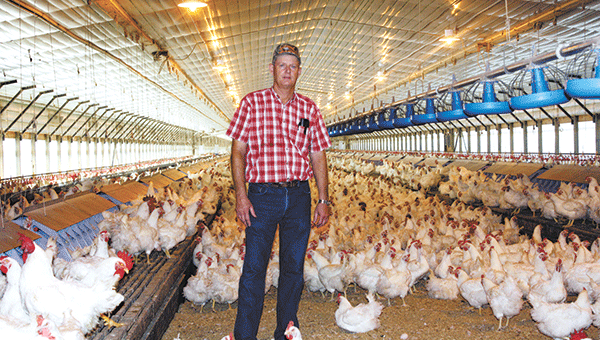Poultry industry eyes avian flu
Published 12:00 am Friday, February 5, 2016

State poultry farmers are keeping their eyes on their flocks after avian flu was found in Indiana. Local poultry farmer Tommy Thompson is shown in this file photo.
Is county’s largest ag commodity
Poultry farmers across the state are monitoring their flocks closely after an outbreak of high pathogen avian influenza was confirmed in Indiana.
An outbreak of the deadly disease in the state could create a downturn in production that impacts the state’s economy.
The state’s poultry industry creates more than $15 billion in annual revenue and employs more than 86,000 workers in the state, according to the Alabama Poultry and Egg Association.
In Covington County, poultry and egg production is the largest agricultural commodity, contributing 56.2 percent of the county’s total agricultural and forestry production or $112 million and some 690 jobs.
Chuck Simon, Covington County’s Extension coordinator, said he had not personally spoken to any local poultry farmers about the avian flu.
However, Dr. Ken Macklin, a poultry scientist with the Alabama Cooperative Extension System, said tests from the Indiana turkey flock showed a different strain of avian influenza from the 2015 avian influenza outbreak that hit the country’s poultry industry.
“The United States Department of Agriculture’s Animal and Plant Health Inspection Service confirmed that the Indiana flock was infected with H7N8 highly pathogenic avian influenza,” Macklin said. “While this is a different strain of HPAI than the strain that caused the 2015 outbreak, it is deadly to domestic chickens and turkeys.”
On Thursday, Alabama Commissioner of Agriculture and Industries John McMillan reassured Alabamians that the department was continuing its surveillance for avian flu and that the HPAI Preparedness and Response plan was in place.
“Every flock of chickens in Alabama is tested for avian influenza before it is processed for human consumption,” he said.
For consumers, Macklin said poultry products are safe to eat.
“Infected flocks do not enter the human food chain,” he said.
Since the new strain found in Indiana is considered highly pathogenic, the mortality rate is extremely high.
Strong biosecurity measures are followed in Alabama’s poultry industry, which Macklin says is the best defense to avian flu.
“There are many steps in a good biosecurity plan,” he said. “Practicing good sanitation and following appropriate biosecurity measures are our best safeguard against this as well as other infectious diseases.”
Biosecurity steps should include:
• Isolating birds from other animals;
• Wearing clothing designed only for use at the poultry house;
• Minimizing access to people and unsanitized equipment;
• Keeping the area around the poultry buildings clean and uninviting to wild animals and birds;
• Sanitizing the facility between flocks;
• Cleaning equipment entering and leaving the farm;
• Having an all-in, all-out policy regarding the placement and removal of the poultry;
• Properly disposing of bedding material and mortalities; and
• Avoiding contact with migratory waterfowl.
Alabama State Veterinarian Dr. Tony Frazier will lead the state’s response effort if the disease is detected in Alabama poultry.
Frazier said it was important for poultry owners and producers to strictly adhere to the biosecurity guidelines.
Huck Carroll, communications director at the poultry and egg association, said that Frazier was the go-to-guy for avian flu information.
Additionally, farmers are to call 334-240-6584 if their birds show unusual signs of the disease or their flock experiences unexplained mortalities.




